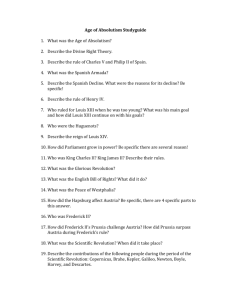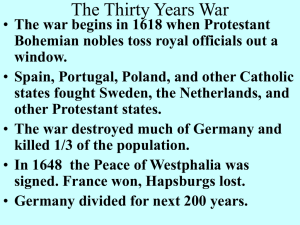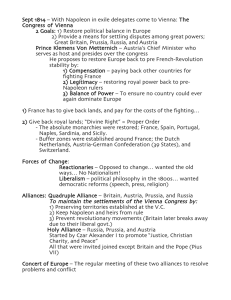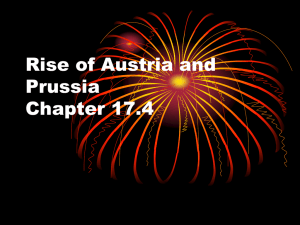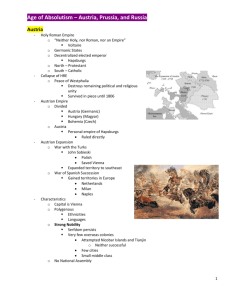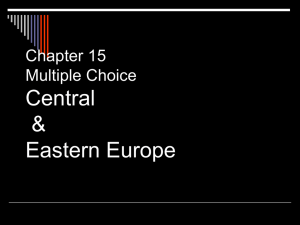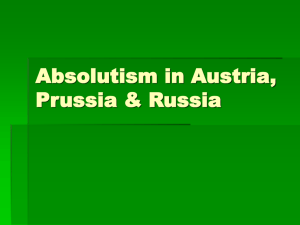Central European Monarchs Clash
advertisement
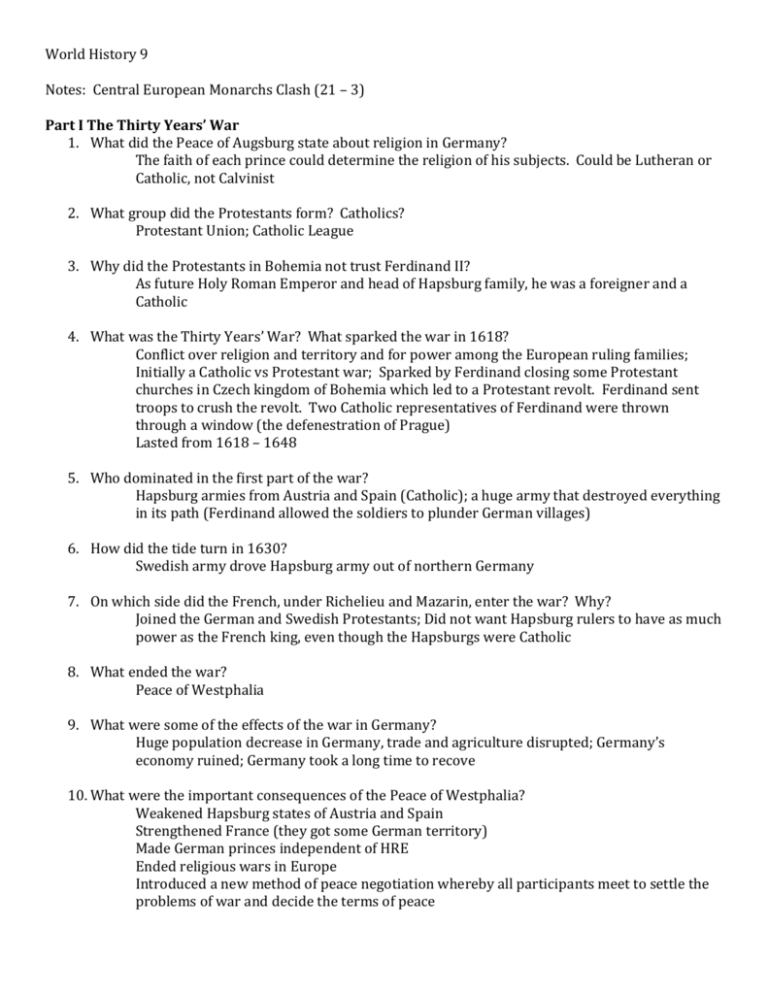
World History 9 Notes: Central European Monarchs Clash (21 – 3) Part I The Thirty Years’ War 1. What did the Peace of Augsburg state about religion in Germany? The faith of each prince could determine the religion of his subjects. Could be Lutheran or Catholic, not Calvinist 2. What group did the Protestants form? Catholics? Protestant Union; Catholic League 3. Why did the Protestants in Bohemia not trust Ferdinand II? As future Holy Roman Emperor and head of Hapsburg family, he was a foreigner and a Catholic 4. What was the Thirty Years’ War? What sparked the war in 1618? Conflict over religion and territory and for power among the European ruling families; Initially a Catholic vs Protestant war; Sparked by Ferdinand closing some Protestant churches in Czech kingdom of Bohemia which led to a Protestant revolt. Ferdinand sent troops to crush the revolt. Two Catholic representatives of Ferdinand were thrown through a window (the defenestration of Prague) Lasted from 1618 – 1648 5. Who dominated in the first part of the war? Hapsburg armies from Austria and Spain (Catholic); a huge army that destroyed everything in its path (Ferdinand allowed the soldiers to plunder German villages) 6. How did the tide turn in 1630? Swedish army drove Hapsburg army out of northern Germany 7. On which side did the French, under Richelieu and Mazarin, enter the war? Why? Joined the German and Swedish Protestants; Did not want Hapsburg rulers to have as much power as the French king, even though the Hapsburgs were Catholic 8. What ended the war? Peace of Westphalia 9. What were some of the effects of the war in Germany? Huge population decrease in Germany, trade and agriculture disrupted; Germany’s economy ruined; Germany took a long time to recove 10. What were the important consequences of the Peace of Westphalia? Weakened Hapsburg states of Austria and Spain Strengthened France (they got some German territory) Made German princes independent of HRE Ended religious wars in Europe Introduced a new method of peace negotiation whereby all participants meet to settle the problems of war and decide the terms of peace 11. How did the Peace of Westphalia lay the foundations of modern Europe? Abandoned idea of Catholic empire that would rule most of Europe; recognized Europe as a group of equal, independent states; marked the beginning of the modern state system Part II States Form in Central Europe 12. Why were strong states more slow to develop in central Europe than in western Europe? Economy was very different: in western Europe, serfs could win freedom and moved to towns to join middle-class; middle-class gained power because of commercial revolution and capitalism. In eastern Europe, nobles restricted serfs from gaining freedom so they could produce more on farms – the surplus could be sold 13. What were the problems that caused the decline of Poland, the Ottoman Empire, and the Holy Roman Empire? Polish nobles restricted power of king (little income, no standing army, no legal courts), so no strong ruler could unify the state Ottoman conquered Hungary and threatened Vienna, but was weakened and could conquer no more of Europe HRE – weakened by 30 Years’ War; couldn’t command obedience of German states; had no real power 14. What steps did the Hapsburg take to become absolute monarchs in Austria? Reconquered Bohemia during 30 Years War and wiped out Protestantism there; created a new nobility there that pledged loyalty to them; centralized the govt and created a standing army; by 1699 had retaken Hungary from Ottoman Empire 15. Why was the Hapsburg Empire difficult to rule? Charled VI became Hapsburg ruler in 1711; difficult to rule because many different people lived within its borders: Czechs, Hungarians, Italians, Croatians, and Germans. The Hapsburg ruler wore the crowns of Austria, Hungary, and Bohemia 16. Who inherited the throne of Austria and became the ruler of the all the Hapsburg lands? Charles VI’s daughter, Maria Theresa Part III Prussia Challenges Austria 17. How did the Hohenzollerns build a strong, absolute monarchy in Prussia? Building a strong army, paid for permanent taxation; weakened the representative assemblies of their territories; bought cooperation of the Junkers (nobles) by giving them exclusive right to be officers in his army. Prussia became a rigidly controller, highly militarized society 18. Who was Frederick the Great and how did he rule Prussia? Absolute ruler of Prussia from 1712 – 1786; son of Frederick William; followed his father’s military policies, but encouraged religious toleration and legal reform. Believed a ruler should be like a father to his people (read primary source excerpt pg 606) 19. What was the War of Austrian Succession fought over? What country helped Austria? What was the result? Fred II in Prussia and Maria Teresa in Austria became rulers of their countries within 5 months of each other. Fred wanted the Austrian region of Silesia which bordered Prussia and had iron ore. He sent his army to occupy Silesia starting the war Great Britain Maria Teresa stopped Prussian aggression, but did not regain Silesia. Prussia became very powerful 20. What alliances were formed after the War of Austrian Succession? Austria, France, and Russia; Prussia and Britain 21. What sparked the Seven Years’ War? How did that war change Europe? How did it change other parts of the world? Fred attacked Saxony, an Austrian ally. Soon every great European power was involved; fought on 3 continents; 1756 – 1763; did not change Europe; France lost colonies in North America, Britain gained sole economic domination of India
